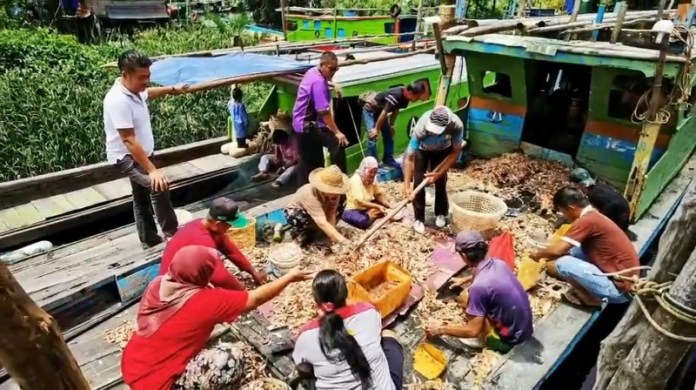
By D’Drift Team
MALUDAM, Oct 13: Maludam is a small but intriguing rural town with many interesting eco-tourism activities to explore but it lacks a tourist information centre which can play an important role in telling the town’s many unique stories as well as act as the main point of contact for visitors to learn about available tourism products and for travel planning inquiries.
Located about 130km from Kuching, the coastal town which is famous for the Maludam National Park has so much to offer, from stunning sunsets over Tanjung Riong which is dotted with headless coconut trees to tales of ghostly guardians of long leaf fig trees (‘pokok ara’ or ficus tree), an abundance of food from the sea and various cottage industries.
Entrepreneur Kiing Sie Kai shared that there are three large and tall ficus trees in different areas within the town that appeared to be connected in a straight line which are homes to hornbills, various birds and monkeys.
“According to local legends, each of the trees has an invisible watchman (‘penunggu’ in Malay) who guards the trees as the ground surrounding the trees has less long weeds, grasses or overgrown vegetation as if someone has walked around it.
“No one dares to cut them down or go near them. One of the trees is the home to several hornbills species like the oriental pied and rhinoceros hornbills which would flock to it, sometimes up to 20, for the fruits. The other trees are homes to monkeys with different ‘tuai rumah’ for each,” he told DayakDaily when met yesterday.


One of the trees is located near his greenhouse farm that currently grows chillies and has a small river flowing through where he sometimes fishes and also a small tank to raise tilapia fish.
Tanjung Riong, he continued, which is a five-minute drive from the new commercial centre and nestled in a village, is another attraction from which to catch a glimpse of a beautiful sunset.
“It is a unique sight of the ever-changing sunset as it paints the sky with different hues which reach out across the sky and the landscape dotted with headless coconut trees left behind due to erosion.
“And if the weather is good throughout the day, people can also catch the fireflies at another site—also a five-minute drive away— after 8pm and try to catch the adorable Irrawaddy dolphin in the Sg Maludam estuary early in the year,” he added.

Kiing pointed out that Maludam is also famous for the gula apong (caramelised palm sugar) cottage industry operated by locals who produce the natural sweetener on a small scale in the traditional way, that is in their backyard with some using a self-built clay oven.
“Maludam has the best gula apong for its purity. The traditional way of making it is tedious which will take days from preparation to harvesting the sap in bamboo containers and hours of slow cooking as controlling the heat is very important,” he said.
Apart from these hidden gems, there are abundant marine resources which is the main source of income of locals. Jelly fish can be found all year round, while March is the season for red shrimps, ‘lumek’ fish and ‘gonjeng’ fish, and April for puffer fish.
“The town will come alive and it is very happening as people from near and far will come to visit to buy the sea products,” he added.


With Maludam National Park, which is the second largest park in Sarawak covering an area of 432 square kilometres with the only viable population of the critically endangered Red Banded Langur (a monkey species) remaining in the world today, nestled here, Kiing emphasised that it can become a drawcard to bring visitors to Maludam.
“But a tourist information centre must be set up because many visitors including foreign tourists in the past cannot even find their way to the park because the office is located inside the park itself that is only accessible by a short boat ride.
“In view that a new row of shoplots is up and equipped with basic facilities and frontline businesses like a hotel, eateries, mini marts and supermarket, it is timely for such services to be made available.
“In turn, visitors can further explore other activities, cultural attractions and find hidden gems from the local perspective as Maludam really has so much to offer when it comes to nature and wildlife,” Kiing stressed.
More importantly, he said, Maludam town is in a strategic location, that is roughly the centre point between Triso and Pusa, and is set to thrive further in five years’ time with the completion of the 4.8km Batang Lupar Bridge which will link major towns from Samarahan to Betong.
He added, more needs to be done by the State government with private sector and community participation to develop and activate the tourism industry here with well packaged tourism activities to enable visitors to have a unique experience of this rural town. — DayakDaily









